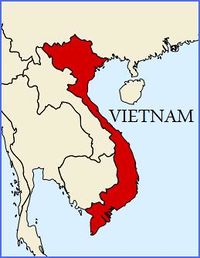User:YouKnowWhatTheMusicMeans/Small Vietnamese restaurants
| Small Vietnamese Restaurants | ||||||||||||
|---|---|---|---|---|---|---|---|---|---|---|---|---|

| ||||||||||||
| Scientific Classification | ||||||||||||
| ||||||||||||
| Species | ||||||||||||
| Hanoiellus minora familiaris
Hanoiellus minora bono |
The Small Vietnamese Restaurant (Hanoiellus minora) is a common species of business in the kingdom Servata, the restaurants. As their name indicates, the species originates from Vietnam. However, only a subspecies, Hanoiellus minora bono, is still present in Vietnam and some parts of America and Western Europe, though it is rare in the latter two regions. Its most common subspecies, Hanoiellus minora familiaris, is widespread in North America and Western Europe, where it is considered an invasive species.
Characteristics[edit | edit source]
Note: Unless indicated, all of the following text refers to Hanoiellus minora familiaris.
Small Vietnamese restaurants are most common on commercial district city streets, and are typically small and slightly grimy. Although these restaurants will almost invariably be closed or have little to no clientele, this is a natural part in their maple-like reproduction, in which a very large amount are created with very few surviving.
As is typical for members of Order Orientales, the signage on Small Vietnamese restaurants typically includes but is not limited to the following: Palace (or other words that create a royal feel e.g. Temple, Pagoda), Hanoi, Buffet, Super, Ho Chi Minh, or Coconut Milk. In terms of physical appearance, the Small Vietnamese restaurant often uses buildings and façades abandoned by other restaurants that have outgrown them, much like the humble hermit crab. However, they often do little to hide this fact, often as a way to catch unwitting humans. In fact, it has been well documented that there has been many a human approaching what was formerly a Pizza Hut, only to disappointingly find out later that it had been replaced by a Small Vietnamese restaurant.
As with all members of Kingdom Servata, its primary prey are Humans (Homo Sapiens), specifically their wallets. Its business model, first studied by Charles Darwin, is widely known as it contains obvious proof of microevolution. According to Darwin, its prices (their primary way of catching humans) "change from generation to generation as the economic climate changes. As the [humans] get richer, their prices go up... but as prey gets fewer and far between due to decreasing coffers, the prices get lower again."
Unlike several of its fellow species, Small Vietnamese restaurants have never been domesticated successfully. However biologists are going "to keep on trying," in the words of Small Vietnamese restaurant specialist Lionel Irving. Irving thinks he "will eventually domesticate it someday. Here at MIT, we've successfully domesticated the Greasy Chicken Shack (Rurales harlandsandersi) into what we now know as KFC. Recently, we've even domesticated the Small Chinese restaurant (Szechuanus minora) into what we now know as Panda Express!... so Small Vietnamese restaurants aren't far off."